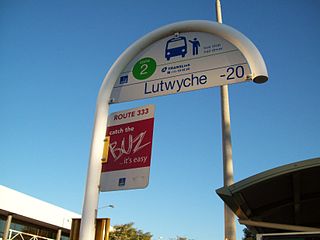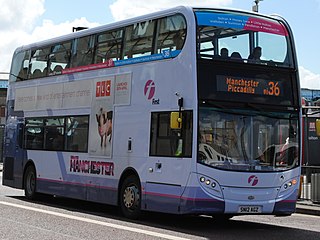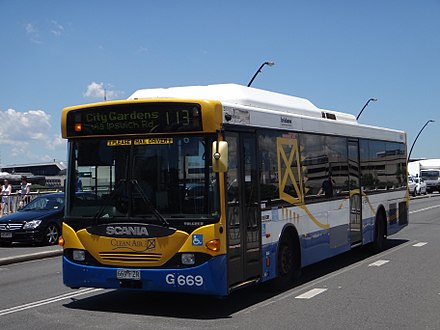
Chermside is a major suburb of the City of Brisbane, Queensland, Australia. The suburb is situated just 9km north of the city and is one of Brisbane's fastest developing suburbs. Chermside is known as a mini CBD of Brisbane. It is home to the largest Westfield shopping centre in Australia.

Carina is a suburb of Brisbane, Australia. It is located 7 kilometres (4.3 mi) east of the CBD, and borders Carindale, Carina Heights, Cannon Hill and Camp Hill.

Bus upgrade zones, commonly abbreviated to BUZ, are a feature of Brisbane's public transport system. The name is given to high-frequency bus routes operated by Brisbane Transport, the Brisbane City Council agency that operates the city's public bus services for TransLink. All BUZ services run at least every fifteen minutes from around 6:00am to 11:30pm seven days a week and at least every ten minutes during peak hours from Monday to Friday.

First Greater Manchester is a bus operator in Greater Manchester. It is a subsidiary of FirstGroup.

Auchenflower is an inner suburb of the City of Brisbane, Queensland, Australia.

Transport in Brisbane, the capital and largest city of Queensland, Australia, is provided by road, rail, river and bay ferries, footpaths, bikepaths, sea and air.
The Aspley Bus Station, at Aspley, Queensland, Australia, is served by TransLink bus routes. It is part of the Aspley Hypermarket Shopping Centre. It is in Zone 2 of the TransLink integrated public transport system.

The Brisbane tramway network served the city of Brisbane, Australia, between 1885 and 1969. It ran on standard gauge track. The electric system was originally energised to 500 volts, and subsequently increased to 600 volts. All tramcars built in Brisbane up to 1938 had an open design. This proved so popular, especially on hot summer nights, that the trams were used as fundraisers and often chartered right up until the last service by social groups.

Metro Tasmania, commonly called Metro, a Tasmanian Government business enterprise, is the largest bus operator in the state of Tasmania, Australia, with operations in three of the four largest urban centres of Hobart, Launceston, and Burnie. Urban services in Devonport are provided by a private operator, Merseylink Coaches, although Metro does operate a route via Devonport which links the Mersey Community Hospital in Latrobe with the North-West Regional Hospital in Burnie. Services are provided by Metro under a range of urban and non-urban contracts with the Transport Commission, a division within the Department of State Growth.

Gympie Road is a major road in the northern suburbs of Brisbane, Queensland, Australia. The road forms part of the main road route from the Brisbane Central Business District (CBD) to the northern suburbs, Sunshine Coast and east coast of Queensland.
Transperth is the brand name of the public transport system serving the city and suburban areas of Perth, the state capital of Western Australia. It is operated by the Public Transport Authority.

In Queensland, Australia, public bus services are coordinated by the Queensland Government's Department of Transport and Main Roads and provided by over 1000 operators. The coordination of public bus transport generally falls under three schemes: TransLink services, QConnect services and the remaining rural/regional school services. Some operators also provide entirely private bus services in Queensland which are not subject to the same route and ticketing regulation as the public route providers, or segments thereof, are.
CityGlider is a brand name applied to a pair of high-frequency bus routes operated by Brisbane Transport in Brisbane, Australia. Both are operated by dedicated fleets of buses vinyled in either blue or maroon liveries with a gliding possum motif. Bus stops serviced by the CityGlider services are identified with signs and painted kerb. Both operate 24 hours a day on Fridays and Saturdays.

The Brisbane trolleybus system was part of the public transport network in Brisbane, Australia from 1951 until 1969. The Brisbane City Council operated 36 Sunbeam trolleybuses on a 28 kilometre network.

Since the mid-1990s, a 27 kilometre bus rapid transit network has been developed in Brisbane, Australia. It comprises grade-separated bus-only corridors, complementing the Queensland Rail City network. Management of the busway network is the responsibility of TransLink as coordinator of South East Queensland's integrated public transport system.

The Schaffhausen trolleybus system is part of the public transport network of Schaffhausen, capital city of the canton of Schaffhausen, Switzerland. It is also Switzerland's youngest and smallest such system.
Transdev Australasia is an operator of bus, ferry, light rail and rail services in Australia and New Zealand. It is a subsidiary of French-based, international Transdev. It was formed in 2013 by grouping the operations of Veolia Transport Australia and former Transdev together, as a result of the global rebranding from Veolia Transdev to Transdev.

The Newcastle Light Rail is a light rail system in Newcastle, New South Wales, running from Newcastle Interchange through the central business district to Pacific Park. Major construction commenced in September 2017 and the line was opened on 17 February 2019. It is operated by Newcastle Transport.

Old Cleveland Road Tramway Tracks is a heritage-listed tramway at Old Cleveland Road, Carina, City of Brisbane, Queensland, Australia. It was built in 1948 by Brisbane City Council. It is also known as Belmont Electric Tramway. It was added to the Queensland Heritage Register on 24 March 2000.
Brisbane Metro is a future high-frequency Bus rapid transit system in the Australian city of Brisbane. It will consist of two routes that will service the Brisbane central business district every three minutes during peak times and would be able to transport 3,000 passengers per hour per direction.























